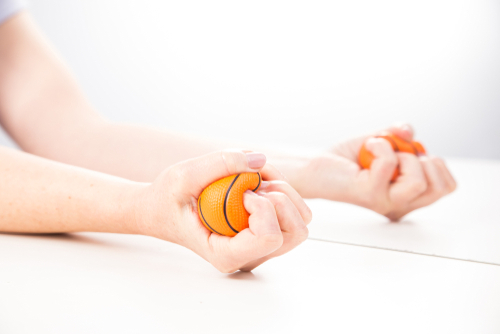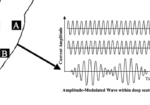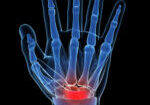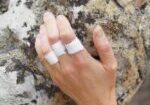Does mirror therapy work for hand therapy patients with general orthopedic conditions?
Filed under Reviews, Treatments
By: Maddie Mott
Rostami, R. H., Arefi, A., & Tabatabaei, S. (2013). Effect of mirror therapy on hand function in patients with hand orthopaedic injuries: a randomized controlled trial. Disability and Rehabilitation, 35(19). 1647-1651. DOI: 10.3109/09638288.2012.751132
The Skinny:
How does mirror therapy work? Mirror therapy (MT) is performed by placing the patient’s injured extremity into a box with a mirror that faces the non-injured extremity. Then, while focusing visual attention on the reflection of the non-injured extremity, the patient performs functional or exercise movements with the un-injured body part. The patient begins to perceive 2 normal hands. Research indicates that mirror neurons are activated and remap the brain’s perception of the injured area. Most research has focused on the effects of MT in the rehabilitation of patients with complex regional pain syndrome and phantom limb however limited research exists evaluating its effectiveness with general orthopedic injuries. The study in this journal article discusses the benefit of MT with patients who present with AROM impairments following orthopedic injuries affecting one or more digits.
In the Weeds:
Researchers performed a randomized control study which included 20 patients in the intervention group and 10 in the control group. In addition to the patients’ standard rehabilitation routine, the patients in the intervention group performed MT 5 times per day for 30 minutes a day over the duration of 3 weeks. MT activities noted by the authors included:
- AROM exercises with flexion, extension, abduction, and adduction of fingers.
- Resistive exercises through manual resistance or tools in putty.
- Functional activities with manipulation of different objects.
Patients in the control group participated in the same exercises and functional activities but were allowed to look at affected extremities throughout the intervention. Pre and post-assessments were based on each patient’s total active motion (TAM) and self-reported score with the Disabilities of Arm, Shoulder, and Hand (DASH). Post assessment analysis concluded significant increases in TAM for both groups but TAM changes were statistically higher for the MT group over the control group. There was also a greater reduction in self-reported DASH scores for patients in the MT group.

Bringing it Home:
This study provides evidence for improving AROM, self-perceived outcomes, and functional independence in patients presenting with orthopedic injuries using MT. The authors noted an additional benefit to mirror therapy is that it may be effective in decreasing extremity guarding and anxiety/fear of limb movement due to the limb being hidden.
Rating: 4 out of 5
This study has limitations regarding small sample sizing which limits the ability to make generalizations based on it. Additionally, this study is the first to demonstrate significant increases in AROM with MT and orthopedic patients. But without neural mapping done during the study to ensure the correct effect of the MT. Future research should be conducted with FMRI during MT to monitor neural mapping.
References
Rostami, R. H., Arefi, A., & Tabatabaei, S. (2013). Effect of mirror therapy on hand function in patients with hand orthopaedic injuries: a randomized controlled trial. Disability and Rehabilitation, 35(19). 1647-1651. DOI: 10.3109/09638288.2012.751132
1 Comment
Leave a Comment
More To Read
IFC vs TENS: Electrical Stimulation for Pain and Swelling
In this article we’re looking at the difference between Inferential Current versus Transcutaneous Electric Nerve Stimulation (IFC vs TENS). Transcutaneous Electric Nerve Stimulation (TENS) TENS variations are often described by their technical characteristics: high frequency, low intensity (conventional TENS) or low frequency, high intensity (acupuncture-like TENS, AL-TENS) (Walsh et al., 2009). How TENS Addresses Pain:…
Read MoreCarpal tunnel syndrome and its association with body mass index, wrist ratio, wrist to palm ratio, and shape index
A literature review of carpal tunnel syndrome and its association with body mass index, wrist ratio, wrist to palm ratio, and shape index Madani, A. M., Gari, B. S., Zahrani, E. M. A., Al-Jamea, L. H., & Woodman, A. (2022). A literature review of carpal tunnel syndrome and its association with body mass index, wrist…
Read MoreHand Pain in Pregnancy and the New Parent
By: Rachel Reed The transition to parenting can be difficult on a mother or parent’s body, especially when considering the increase in repetitive hand use required to care for a baby. The most common upper extremity conditions that develop during pregnancy and postpartum are carpal tunnel syndrome and de Quervain’s tenosynovitis (Wagner, 2019). Frequently, new…
Read MoreClosed Pulley Injuries in Rock Climbers
Mechanism of injury Grades of pulley injury Treatment options for closed rupture Outcome measures Return to climbing Exercise considerations Resources Bollen S. R. (1990). Upper limb injuries in elite rock climbers. Journal of the Royal College of Surgeons of Edinburgh, 35(6 Suppl), S18–S20. Bosco, F., Giustra, F., Lusso, A., Faccenda, C., Artiaco, S., & Massè, A. (2022).…
Read MoreSign-up to Get Updates Straight to Your Inbox!
Sign up with us and we will send you regular blog posts on everything hand therapy, notices every time we upload new videos and tutorials, along with handout, protocols, and other useful information.







Thanks for this review. I find it helpful and supports clinicians being creative in our sessions to see what works best for each client.